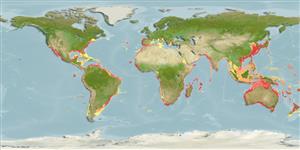Common names from other countries
Пластиножаберные (акулы и скаты) (sharks and rays) >
Carcharhiniformes (Ground sharks) >
Carcharhinidae (Requiem sharks)
Etymology: Carcharhinus: karcharos (Gr.), sharp or jagged; rhinus, an ancient name for sharks, from rhine (Gr.), rasp, both words alluding to a shark's jagged, rasp-like skin. (See ETYFish); brachyurus: a- (Gr.), not; carenatus, alternate spelling of carinatus (L.), keeled or carinate, referring to absence of dermal fold (dorsal ridge) between the dorsal fins [treated as a junior synonym of C. brachyurus by some workers]. (See ETYFish).
More on author: Günther.
Issue
Carcharhinus acarenatus Moreno & Hoyos, 1983 may be a valid species. See ECoF.
Environment: milieu / climate zone / depth range / distribution range
экология
морской; солоноватоводный ассоциированный с рифами; мигрирует в океане (Ref. 51243); пределы глубины 0 - 360 m (Ref. 58018). Subtropical; 45°N - 52°S, 122°W - 180°E
Western Atlantic: Mexico, Gulf of Mexico, Brazil to Argentina. Eastern Atlantic: off France southward and around the coast of southern Africa to central Natal, South Africa (Ref. 5578), including the Mediterranean. Possibly two separate populations in southern Africa (Ref. 3209). Western Pacific: Japan to New Zealand. Eastern Pacific: southern California, USA to the Gulf of California in Mexico and Peru.
Length at first maturity / Size / Вес / Возраст
Maturity: Lm 230.0, range 245 - 240 cm
Max length : 325 cm TL самец/пол неопределен; (Ref. 2334); наибольший вес (опубликованные данные): 304.6 kg (Ref. 40637); наибольший возраст (опубликованны данные): 30 годы (Ref. 3209)
колючие лучи спинного плавника (общее число) : 0; колючие лучи анального плавника: 0. A large shark to with a bluntly pointed, broad snout, narrow, bent cusps on the upper teeth, and with no interdorsal ridge (Ref. 5578). Grey to bronzy in color, white below (Ref. 5578); fins mostly plain except for dusky tips on pelvic fins, as well as dusky to black tips and rear edges on pectoral fins (Ref. 9997).
A coastal and offshore shark (Ref. 9997) found along continental margins in most tropical and temperate seas. Occasionally enters large coastal bays and inshore areas (Ref. 6390). Occasionally found near the bottom (Ref. 6808). Migratory in the northern part of its range, moving northward in spring and summer and southward in autumn and winter (Ref. 244). Feeds on pelagic and bottom bony fishes, cephalopods, and small sharks and rays (Ref. 5578). Viviparous (Ref. 50449). Undoubtedly utilized for human consumption where it occurs (Ref. 244). Implicated in shark attacks on people (Ref. 9997).
Viviparous, with a yolk-sac placenta. Litter contains 7 to 20 pups (Ref. 6871, 6390). Young born at 59 - 70 cm TL (Ref. 6390). Pupping may occur at any time of the year but there is a peak in births in summer (Ref. 6390). Distinct pairing with embrace (Ref. 205).
Compagno, L.J.V., 1984. FAO Species Catalogue. Vol. 4. Sharks of the world. An annotated and illustrated catalogue of shark species known to date. Part 2 - Carcharhiniformes. FAO Fish. Synop. 125(4/2):251-655. Rome: FAO. (Ref. 244)
Статус Красного Списка МСОП (Ref. 130435)
Угроза для людей
Traumatogenic (Ref. 4690)
Использование человеком
рыболовство: не имеет хозяйственного значения; объект спортивного рыболовства: да
дополнительная информация
инструменты
Специальные отчеты
Скачать в формате XML
ресурсы в Интернет
Estimates based on models
Preferred temperature (Ref.
115969): 11.6 - 23.8, mean 17.4 (based on 797 cells).
Phylogenetic diversity index (Ref.
82804): PD
50 = 0.5000 [Uniqueness, from 0.5 = low to 2.0 = high].
Bayesian length-weight: a=0.00468 (0.00230 - 0.00950), b=3.08 (2.91 - 3.25), in cm Total Length, based on LWR estimates for this species & Genus-body shape (Ref.
93245).
Trophic level (Ref.
69278): 4.5 ±0.0 se; based on diet studies.
устойчивость к внешним воздействиям (Ref.
120179): очень низкий, минимальное время удвоения популяции более 14 лет (K=0.04; tm=5-20; tmax=30; Fec=7).
Fishing Vulnerability (Ref.
59153): Very high vulnerability (87 of 100).
Climate Vulnerability (Ref.
125649): High vulnerability (57 of 100).
